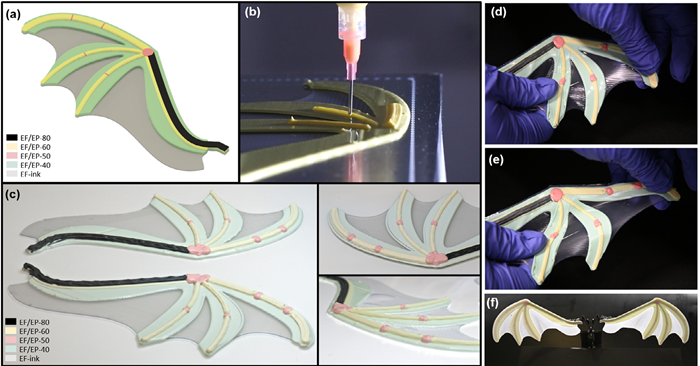SUTD Breaks New Ground in 3D Printed Soft Robotics with Largest Range of Polymer Hybrids
SUTD - Vincent Sebastian Joseph, Theo Calais, Thileepan Stalin, Snehal Jain, Naresh Kumar Thanigaivel, Naresh D. Sanandiya and Pablo Valdivia y Alvarado
These newly developed resins are tougher and will also allow for more robust integration of mechatronic components in 3D printed multi-material structures.
In a study published in Applied Materials Today, researchers from Singapore have developed the largest range of silicone and epoxy hybrid resins for the 3D printing of wearable devices, biomedical equipment, and soft robotics. The range of tunable functionally graded materials, which displayed over five orders of magnitude of elastic modulus, demonstrated excellent interfacial toughness, higher precision in complex structures and better fabrication control for the integration of mechatronic components.
The multi-disciplinary team from the Singapore University of Technology and Design (SUTD) highlighted the issue on the potential of soft robotics being limited in its robustness and applicability in their paper, ‘Silicone/Epoxy Hybrid Resins with Tunable Mechanical and Interfacial Properties for Additive Manufacture of Soft Robots’.
For instance, the integration of mechatronic components such as printed circuit boards (PCB), sensors, batteries, pneumatic fittings, cables and pumps, into soft and composite bodies continue to be a challenge, while design complexity and fabrication control are hindered by the traditional molding and casting approaches used for integration.
To address these limitations, the team developed a novel range of polymer hybrids which can exhibit a wide range of mechanical characteristics from very soft to very stiff for use in soft robotics and easier assembly in traditional hard mechatronics components respectively. The polymer hybrids display excellent toughness and chemical compatibility to withstand large strains, and be processable via direct-ink writing to allow advanced digital manufacturing of complex structures.
The range of novel silicone-epoxy hybrids were made of soft platinum-catalyzed elastomers and hard epoxy resins cured by acid anhydride hardeners. Choosing acid anhydrides instead of commonly used amine-based hardeners allowed for an unprecedented chemical compatibility between silicone and epoxy phases, and also enabled precise tuning of mechanical and interfacial characteristics by varying its compositions.
The resulting family of hybrids displayed over five orders of magnitude of elastic modulus, ranging from 22 kPa to 1.7 GPa, which is probably the largest range reported for tunable functionally graded materials. Composites with close composition exhibit excellent interfacial toughness from 0.8 to 3.0 kJ.m-2, enabling robust interfaces between soft bodies and a wide range of traditional mechatronic components. The addition of rheological modifiers - in this case, laponite nanoclay - to ink formulations enabled the additive manufacturing of complex three-dimensional composite structures (refer to image).
 Design and fabrication of a bat-wing inspired multi-material hybrid structure. (a) Illustration of the structural design. (b) Direct-ink-writing of the hybrid structure. (c) Cured structure (area of ~90 cm 2 per wing, membrane thickness ~0.7 mm, total arm thickness ~3.5 mm). (d) Flexibility and cohesiveness of the wing structure under small strains. (e) Flexibility and cohesiveness of the wing structure under large strains. (f) Wings mounted on actuation mechanism.
Design and fabrication of a bat-wing inspired multi-material hybrid structure. (a) Illustration of the structural design. (b) Direct-ink-writing of the hybrid structure. (c) Cured structure (area of ~90 cm 2 per wing, membrane thickness ~0.7 mm, total arm thickness ~3.5 mm). (d) Flexibility and cohesiveness of the wing structure under small strains. (e) Flexibility and cohesiveness of the wing structure under large strains. (f) Wings mounted on actuation mechanism.
The advantages of this new family of hybrids were demonstrated through four main examples. First, a PCB was integrated to a soft membrane that could be stretched more than 200% without displaying any interfacial damage. Second, a finger articulation was successfully reproduced from anatomical models, with robust integration of bone-like, tendon-like, and ligament-like structures. Then, the structure and performance of reinforced pneumatic actuators with tunable axial deformations was detailed. Finally, a bat-inspired wing structure capable of supporting fast dynamics and large bending deformations was reported.
The performances in these examples could only be achieved due to the advanced fabrication approach that enabled the robust combination of materials at multiple scales and high resolutions that traditional casting or molding approaches could not attain.
"The findings and the understanding derived from this work, at the interface of chemistry, physics, and engineering, represent a substantial contribution to materials engineering especially when applied to soft robotics. Our advanced fabrication approaches facilitate robust material combinations at multiple scales and high resolutions enabling novel applications to a broad range of key sectors, such as wearables, healthcare, and more specifically soft robotics," said principal investigator Assistant Professor Pablo Valdivia y Alvarado from SUTD’s Engineering Product Development programme.
Acknowledgements:
This research project is supported by A*STAR under its Science and Engineering Research Council (SERC) Award 1822500053, and by SUTD's Digital Manufacturing and Design (DManD) centre and SUTD's International Design centre (IDC) under grants RGDM1620401, RGMD1620501, IDG31600101.
Reference:
Silicone/Epoxy Hybrid Resins with Tunable Mechanical and Interfacial Properties for Additive Manufacture of Soft Robots, Applied Materials Today. (DOI: 10.1016/j.apmt.2021.100979)